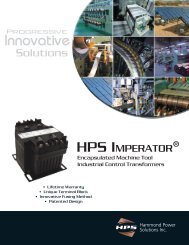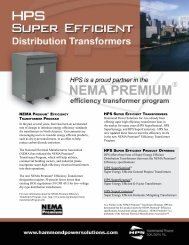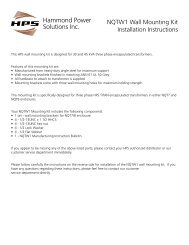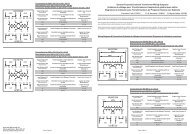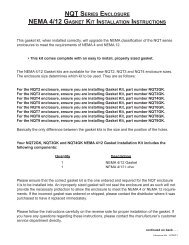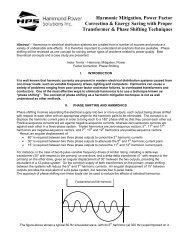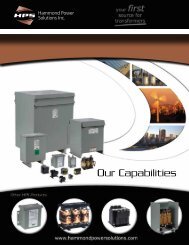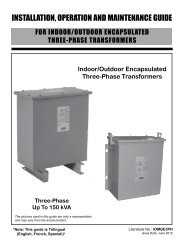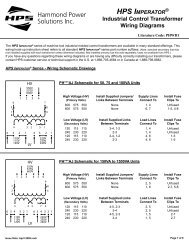installation, operation and maintenance guide - Hammond Power ...
installation, operation and maintenance guide - Hammond Power ...
installation, operation and maintenance guide - Hammond Power ...
Create successful ePaper yourself
Turn your PDF publications into a flip-book with our unique Google optimized e-Paper software.
Page 10air, metal, concrete, wood or any combination.Amplification of audible sound can occur in a givenarea due to the presence of reflecting surfaces ormounting surfaces.Sound levels for transformers can vary from 60 dBAfor a 500 kVA to 76 dBA for a 10,000 kVA <strong>and</strong> more.These sound levels are determined by CSA <strong>and</strong>ANSI St<strong>and</strong>ards <strong>and</strong> are based on the following:• Sound levels specified are for a non-loadedcondition at rated voltage <strong>and</strong> frequency• Units are tested in a low ambient noiseenvironment• Walls or reflecting surfaces are at least 10'away from all sides of the transformer.It should be noted therefore that operatingtransformers when connected to a load, will exhibithigher sound levels than the st<strong>and</strong>ards referenced.Additionally, transformers are frequently installedin more confining electrical rooms which will havethe effect of increasing the apparent sound level.Transformers will exhibit higher than normal soundlevels if installed on suspended floors that mayresonate. It is a good practice to install power units onthe ground floor or basement level to avoid suspendedfloors <strong>and</strong> away from office or living quarters. Vibrationdampeners or spring isolators are also recommendedto attenuate sound levels.Flexible connectors can be installed between the busbars <strong>and</strong> other equipment to avoid vibration transfer.Ensure all mounting bolts are tightened <strong>and</strong> thatthe transformer housing is securely assembled <strong>and</strong>separate from the transformer itself.Transformers installed in close proximity to each othercan experience a resonant frequency between themthat results in higher than normal sound levels.If noise levels are a factor in the location of anytransformer, special consideration should be givento the <strong>installation</strong> site <strong>and</strong> attenuation equipment.Interrupting the sound transmission medium with the<strong>installation</strong> of sound absorbing foam or fiberglassmaterial on the ceiling or walls, could be considered.GROUNDINGAll non-current carrying metal parts in transformersmust be grounded, including the core <strong>and</strong> enclosure.St<strong>and</strong>ard construction has the core grounded throughdirect contact with the clamping structure. Cores thathave metal bolts passing through them are insulatedfrom the core clamps <strong>and</strong> grounded at a single point.Isolating the core in this manner is necessary onthese transformers only to determine if there is aninsulation failure in any through-bolts that might causea high circulating current or hot spot. There are norequirements for isolating cores in any st<strong>and</strong>ardsincluding UL, ANSI, CSA, IEEE <strong>and</strong> IEC.FIELD TESTINGIt is recommended that separate field testing <strong>and</strong>inspection be made before placing a transformer inservice to determine that it is in satisfactory operatingcondition <strong>and</strong> to obtain data for future comparison.Tests <strong>and</strong> procedures as recommended in ANSI/IEEEis recommended as a minimum.Where low-frequency applied-voltage, inducedvoltage,insulation resistance or megger, foracceptance are conducted the test voltages shall notexceed 75% of factory test values. When field testsare made on a periodic basis, it is recommendedthat the test voltages be limited to 65% of factory testvalues. Disconnect surge arrestors if supplied. It is



